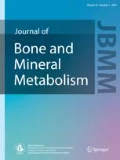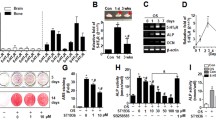Abstract
In view of the opposite effects of gut and brain serotonin in bone, the key role of Wnt β/catenin pathway in osteoblastic proliferation and the controversial bony effects of selective serotonin reuptake inhibitors antidepressants, the present study investigated the effects of escitalopram alone and in combination with carbidopa (to block gut-derived serotonin) on markers of bone turnover and Wnt signaling and micro-CT in male Wistar rats. Escitalopram (2.0 mg/kg, p.o.) and carbidopa (10 mg/kg, p.o.) were administered daily for 40 days following which indicators of reduced (dickkopf-1, sclerostin), and increased (alkaline phosphatase) bone formation and bone resorption markers (receptor activator of nuclear factor κB ligand, tartrate-resistant acid phosphatase 5b) were determined. Our results indicated that escitalopram adversely affected bone as indicated by reduced bone formation and enhanced bone resorption. Further, the effects of escitalopram on bone formation were possibly mediated through gut serotonin while the mechanisms responsible for effects on resorption seem unrelated to gut serotonin. The promising effects of carbidopa on bone formation, as observed in our study, open up exciting possibilities for this drug requiring further investigations.


Similar content being viewed by others
References
Dubnov-Raz G, Hemila H, Vurembrand Y, Kuint J, Maayan-Metzgar A (2012) Maternal use of selective serotonin reuptake inhibitors during pregnancy and neonatal bone density. Early Hum Dev 88:191–194
Diem SJ, Joffe H, Larson JC, Tsai JN, Guthrie KA, LaCroix AZ, Ensrud KE, Freeman EW, Leder BZ (2014) Effects of escitalopram on markers of bone turnover: a randomized clinical trial. J Clin Endocrinol Metab 99:E1732–E1737
Battaglino R, Vokes M, Schulze-Spate U, Sharma A, Graves D, Kohler T, Muller R, Yoganathan S, Stashenko P (2007) Fluoxetine treatment increases trabecular bone formation in mice (fluoxetine affects bone mass). J Cell Biochem 100:1387–1394
Goltzman D (2011) LRP5, serotonin, and bone: complexity, contradictions, and conundrums. J Bone Miner Res 26:1997–2001
Radaei F, Gharibzadeh S (2013) The effect of carbidopa in carbidopa-levodopa combination on reducing osteoporotic symptoms in Parkinson’s disease patients. Brain Disord Ther 2:2
Westendorf JJ, Kahler RA, Schroeder TM (2004) Wnt signaling in osteoblasts and bone diseases. Gene 341:19–39
Baron R, Rawadi G (2007) Targeting the Wnt/beta-catenin pathway to regulate bone formation in the adult skeleton. Endocrinology 148:2635–2643
Glinka A, WuW Delius H, Monaghan AP, Blumenstock C, Niehrs C (1998) Dickkopf-1 is a member of a new family of secreted proteins and functions in head induction. Nature 391:357–362
Goodwin GM, Green AR (1985) A behavioural and biochemical study in mice and rats of putative selective antagonists of 5-HT1 and 5-HT2 receptors. Br J Pharmacol 84:743–753
Bourke CH, Capello CF, Rogers SM, Yu ML, Boss-Williams KA, Weiss JM, Stowe ZN, Owens MJ (2013) Prenatal exposure to escitalopram and/or stress in rats: a prenatal stress model of maternal depression and its treatment. Psychopharmacology 228:231–241
Smarius LJ, Jacobs GE, Hoeberechts-Lefrandt DH, Kam ML, Van der Post JP, Rijk R, Van Pelt J, Schoemaker RC, Zitman FG, Van Gerven JM, Gijsman HJ (2008) Pharmacology of rising oral doses of 5-hydroxytryptophan with carbidopa. J Psychopharmacol 22:426–433
Kaiser M, Mieth M, Liebisch P, Oberländer R, Rademacher J, Jakob C, Kleeberg L, Fleissner C, Braendle E, Peters M, Stover D, Sezer O, Heider U (2008) Serum concentrations of DKK-1 correlate with the extent of bone disease in patients with multiple myeloma. Eur J Haematol 80:490–494
Gaudio A, Pennisi P, Bratengeier C, Torrisi V, Lindner B, Mangiafico RA, Pulvirenti I, Hawa G, Tringali G, Fiore CE (2010) Increased sclerostin serum levels associated with bone formation and resorption markers in patients with immobilization-induced bone loss. J Clin Endocrinol Metab 95:2248–2253
Lowry OH, Rosebrough NJ, Farr AL, Randall RJ (1951) Protein measurement with the Folin Phenol reagent. J Biol Chem 193:265–275
Ominsky MS, Li X, Asuncion FJ, Barrero M, Warmington KS, Dwyer D, Stolina M, Geng Z, Grisanti M, Tan HL, Corbin T, McCabe J, Simonet WS, Ke HZ, Kostenuik PJ (2008) RANKL inhibition with osteoprotegerin increases bone strength by improving cortical and trabecular bone architecture in ovariectomized rats. J Bone Miner Res 23:672–682
Tenniswood M, Bird CE, Clark AF (1976) Acid phosphatase: androgen dependent markers of rat prostate. Can J Biochem 54:350–357
Yadav VK, Ryu JH, Suda N, Tanaka KF, Gingrich JA, Schutz G, Glorieux FH, Chiang CY, Zajac JD, Insogna KL, Mann JJ, Hen R, Ducy P, Karsenty G (2008) Lrp5 controls bone formation by inhibiting serotonin synthesis in the duodenum. Cell 135:825–837
Yadav VK, Oury F, Suda N, Liu ZW, Gao XB, Confavreux C, Klemenhagen KC, Tanaka KF, Gingrich JA, Guo XE, Tecott LH, Mann JJ, Hen R, Horvath TL, Karsenty G (2009) A serotonin-dependent mechanism explains the leptin regulation of bone mass, appetite, and energy expenditure. Cell 138:976–989
Zhang W, Drake MT (2012) Potential role for therapies targeting DKK1, LRP5, and serotonin in the treatment of osteoporosis. Curr Osteoporos Rep 10:93–100
Hampson G, Edwards S, Conroy S, Blake GM, Fogelman I, Frost ML (2013) The relationship between inhibitors of the Wnt signalling pathway (Dickkopf-1(DKK1) and sclerostin), bone mineral density, vascular calcification and arterial stiffness in post-menopausal women. Bone 56:42–47
Yadav VK, Balaji S, Suresh PS, Liu XS, Lu X, Li Z, Guo XE, Mann JJ, Balapure AK, Gershon MD, Medhamurthy R, Vidal M, Karsenty G, Ducy P (2010) Pharmacological inhibition of gut-derived serotonin synthesis is a potential bone anabolic treatment for osteoporosis. Nat Med 16:308–312
Ducy P, Karsenty G (2010) The two faces of serotonin in bone biology. J Cell Biol 191:7–13
Garfinkel PE, Warsh JJ, Stancer HC, Godse DD (1977) CNS monoamine metabolism in bipolar affective disorder. Evaluation using a peripheral decarboxylase inhibitor. Arch Gen Psychiatry 34:735–739
Yamada J, Sugimoto Y, Ujikawa M (1999) The serotonin precursor 5-hydroxytryptophan elevates serum leptin levels in mice. Eur J Pharmacol 383:49–51
Lee DJ, Tseng HC, Wong SW, Wang Z, Deng M, Ko CC (2015) Dopaminergic effects on in vitro osteogenesis. Bone Res 3:15020
Inose H, Zhou B, Yadav VK, Guo XE, Karsenty G, Ducy P (2011) Efficacy of serotonin inhibition in mouse models of bone loss. J Bone Miner Res 26:2002–2011
Gustafsson BI, Thommesen L, Stunes AK, Tommeras K, Westbroek I, Waldum HL, Slørdahl K, Tamburstuen MV, Reseland JE, Syversen U (2006) Serotonin and fluoxetine modulate bone cell function in vitro. J Cell Biochem 98:139–151
Kostenuik PJ (2005) Osteoprotegerin and RANKL regulate bone resorption, density, geometry and strength. Curr Opin Pharmacol 5:618–625
Halleen JM, Alatal SL, Suominen H, Cheng S, Janckila AJ, Vaananen HK (2000) Tartrate-resistant acid phosphatase 5b: a novel serum marker of bone resorption. J Bone Miner Res 15:1337–1345
Acknowledgements
This work was carried out in UGC-SAP assisted Neurobehavioral Pharmacology Laboratory. We thank M. Raj for helping in arranging carbidopa sample from Shodhana Laboratories, Hyderabad. Special thanks to Dr. Bibhu Prasad Panda, for permission to work in Pharmaceutical Biotechnology Laboratory (Jamia Hamdard). The work was supported by fellowship from AICTE (GPAT).
Author information
Authors and Affiliations
Corresponding author
Ethics declarations
Conflict of interest
The authors report no conflicts of interest.
About this article
Cite this article
Wadhwa, R., Kumar, M., Paudel, Y.N. et al. Effect of escitalopram and carbidopa on bone markers in Wistar rats: a preliminary experimental study. J Bone Miner Metab 37, 36–42 (2019). https://doi.org/10.1007/s00774-018-0908-1
Received:
Accepted:
Published:
Issue Date:
DOI: https://doi.org/10.1007/s00774-018-0908-1




